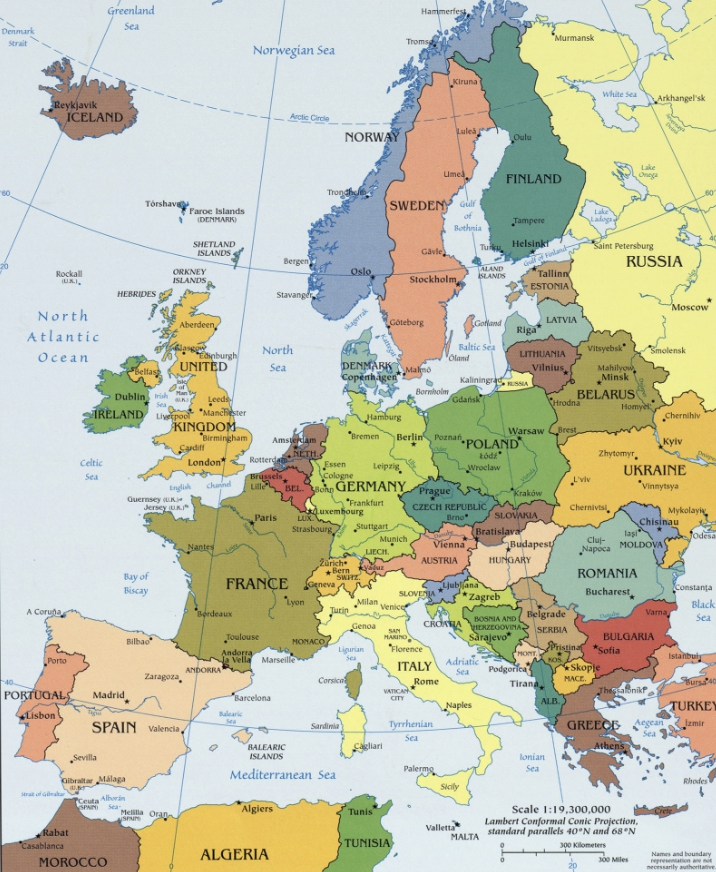
Political Map of Europe
To begin with, Europe refers to the part of the world that lies in the western part of the continent of Eurasia in the Northern Hemisphere, and together with Asia forms a single continent. To be clear, its area is 10 million km2, here live about 20% of the total population of the Earth (743 million people). Moreover, Europe is the largest economic, historical and political center of great importance all over the world.
Geographical position
It is a common knowledge that Europe is washed by the Atlantic and the Arctic Ocean, its shoreline is markedly rugged, its islands area is 730,000 km2, one-fourth of the total area is occupied by the peninsulas: the Kola, the Apennines, the Balkans, the Pyrenees, the Scandinavian, etc. The border between Europe and Asia conventionally runs along east coast of the Ural Mountains, Emba, the Caspian Sea. Kumo-Manych depression and the mouth of the Don.
Besides, the average height of the surface is 300 meters, the highest point is Mount Elbrus (5642 m, the Caucasus Mountains in Russia), the lowest point is -27 m (Caspian Sea). Most of the territory is occupied by plains (East European, Lower and Middle Dnei, Middle European), 17% of the surface is mountains and plateaus (the Urals, Carpathians, Pyrenees, Alps, Scandinavian mountains, Crimean mountains, Balkan mountains), Iceland and the Mediterranean islands in the zone of seismic activity.
Inland waters
It is clear that the majority of the rivers belong to the basin of the Atlantic seas, the smaller part to the basin of the Arctic Ocean and the basin of the internal flow of the Caspian Sea. What is more, the largest rivers of Europe are located mainly on the territory of Russia and Eastern Europe, and there are large rivers in the territory of Western Europe.
The largest rivers are the Volga, the Kama, the Oka, the Danube, the Urals, the Dnieper, the Don, the Dniester, the Rhine, the Elbe, the Vistula, the Tahoe, the Loire, the Oder, the Neman.
In fact, the lakes of Europe have a tectonic origin, which causes their considerable depth, elongated shape and severely cut coastline, these are the flat lakes Ladozhskoe, Onega, Vettern, Imandra, Balaton, mountain – Geneva, Como, Garda.
The territory of Europe
According to the statistics, there are (in whole or in part) 50 independent states. They are Austria, Albania, Andorra, Belarus, Belgium, Bulgaria, Bosnia and Herzegovina, Vatican, Great Britain, Hungary, Germany, Gibraltar, Greece, Denmark, Ireland, Iceland, Spain, Italy, part of Kazakhstan, Latvia, Lithuania, Liechtenstein, Luxembourg , Macedonia, Malta, Moldova, Monaco, Netherlands, Norway, Poland, Portugal, Russian Federation (about 2/3 of the territory of Europe), Romania, San Marino, Slovakia, Slovenia, part of Turkey, Ukraine, Finland, France, Czech Republic, Switzerland, Sweden, Estonia, Yugoslavia (including Serbia and Montenegro).
European countries:
- Western Europe: Austria, Belgium, England, Germany, Ireland, Liechtenstein, Luxembourg, Monaco, Netherlands, France, Switzerland;
- Eastern Europe: Byelorussia, Bulgaria, Hungary, Moldova, Poland, Russia, Romania, Slovakia, Czech Republic, Ukraine;
- Northern Europe: Denmark, Iceland, Latvia, Lithuania, Norway, Finland, Estonia, Sweden;
- Southern Europe: Albania, Andorra, Bosnia and Herzegovina, Vatican, Greece, Spain, Italy, Macedonia, Malta, Portugal, San Marino, Serbia, Slovenia, Croatia, Montenegro.
Major European countries:
- Iceland (102 775 km ², 332 529 people);
- Norway (385,186 km², 5,258,317 people);
- England (133 396 km ², 53 012 456 people);
- Ireland (70,273 km², 4,761,865 people);
- Germany (357,021 km², 82,175,700 people);
- Czech Republic (78,866 km², 10,578,820);
- Belarus (207,595 km², 9,504,700 people);
- Ukraine (603,549 km², 42,467,000 people);
- France (640,679 km², 66,991,000 people);
- Spain (505,992 km², 46,449,565 people);
- Italy (301 340 km², 60 599 936 people);
- Greece (131 957 km ², 10 955 000 people);
- Russia (17,125,191 km², 146,804,372 people).
To conclude, Today, Europe is economic and political entity. However, since its emergence in the ancient Greek world, the concept of Europe has had a complex and rich history. Thus, discussing the concept of Europe it is of paramount importance to state that it has various interpretations. To be more precise, the notion of Europe can be observed through the concept of region and culture. This approach realizes thought three definitions: instituted regions, naively perceived, and denoted.
First of all, it is obvious that Europe is instituted region created by authorities within some organizations. Such approach is the most common and clear for a broad public. However, it is important to realize that the formation of Europe as instituted region is still in progress.
Taking into consideration that regions do not exist without the agency of humankind and appear to be a construct created by human beings, it is clear that Europe is naively perceived regio. With regard to this concept, the idea of Europe is closely related to the notions of community and nationhood. Moreover, very often Europe is perceived as separate continent when in fact it is not. The point is that Europe as a culture realm sets apart from other cultures and appears to be a distinctive culture region. Finally, Europe is denoted region what implies a delimited piece of earth space created by grouping together places that share common characteristics. Thus, the idea of Europe has always been complex and had different interpretations concerning its place in the world.

